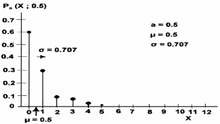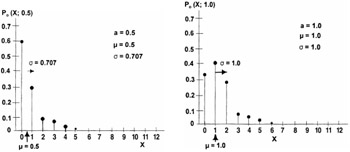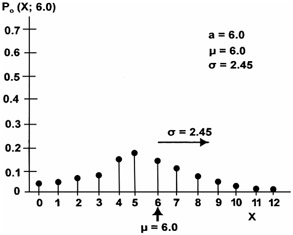POISSON DISTRIBUTION: LIMIT OF BINOMIAL DISTRIBUTION FOR RARE OCCURRENCE
Rare successes: Probability p extremely small but sample size n extremely large, such that binomial mean = np = a is finite. Since p is so small, we can expect that x success will also be small compared to sample size n. The Poisson distribution is also used to compute the probability of the number of "Poisson events" during a given time interval or within a specified region of space.
We already have defined the binomial distribution as:

For the Poisson distribution, however, we:
-
Reduce the permutation factor, since x << n.

-
Combine factors of like powers.

-
Note that because p « 1 and x is not large, we can approximate (1 - p) x = 1.
-
Having mean np = a we can rewrite n = a/p so

-
Limit as p ’ 0 yields exponential

-
The result is the Poisson distribution (one parameter: a).

-
In reliability, the parameter a = t.
-
is the mean number of events per unit time.
-
COMPARISON OF BINOMIAL AND POISSON
The probability density function (pdf) for the binomial distribution is:
B (Xi = x;n, p) = [n!/X!(n - x)!] p x q (n-x)
-
Mean: ¼ = np = a
-
Variance: ƒ 2 = npq = aq
-
Two Parameters: n and p
-
or
-
a(= np) and q = (1- p)
-
On the other hand, the probability function for the Poison distribution is:
where a = n p and q = (1 - p) approx. 1.
-
Mean: ¼ = a
-
Variance: ƒ 2 = a
-
One parameter: a( = np)
| |
A compressor manufacturer has a record of 50 defects per 1000 produced, which corresponds to a defect percentage of 5%. Since the probability of successfully observing a defect is small (p = 0.05), then we can assume a Poisson distribution.
Determine probability of observing defects in batch of n = 10:
Poisson parameter: a = np = 10(0.05) = 0.5
Probability of exactly x = 0 failures:
Probability of exactly x = 1 failure:
Probability of exactly x = 2 failures:
Probability of exactly x = 3 failures:
Figure 16.32 shows the Poisson distribution for each of the failures.

Figure 16.32: Poisson distribution for the four failures.

Special comments:
-
The mean is equal to the parameter a; as a result, the smaller the "a's," the more skewed the probability density function (pdf) is to the left.

-
The standard deviation is equal to the square root of "a"; hence, increasing the value of "a" also increases the standard deviation.
-
The larger the value of "a," the more the Poisson distribution approaches the normal distribution.
| |
EAN: 2147483647
Pages: 252